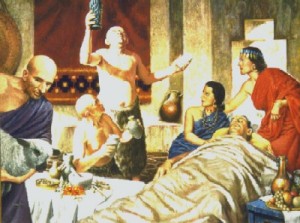 Each issue of The Journal of the American Medical Association includes an excerpt from an issue of exactly 100 years ago. (JAMA has been published continuously since 1883.) The May 7, 1910 issue of JAMA included remarks on how much physicians were paid and, by implication, how they were regarded in 2250 B.C.
Each issue of The Journal of the American Medical Association includes an excerpt from an issue of exactly 100 years ago. (JAMA has been published continuously since 1883.) The May 7, 1910 issue of JAMA included remarks on how much physicians were paid and, by implication, how they were regarded in 2250 B.C.
Ability to pay and malpractice
According to the famous Babylonian Code of Hammurabi (“an eye for an eye”), a physician’s fee varied with the social status of the patient. There were three classes in ancient Babylonian society. The upper class included wealthy landowners, affluent traders, officials, and priests. Freemen were farmers, clerks, and craftsmen. And then there were slaves.
If an upper class citizen was severely wounded and a physician (using his “bronze lancet”) saved his life, the physician received 10 shekels of silver. If the patient was a freeman, the fee was five shekels. For a slave, the physician was paid only two shekels.
JAMA of 1910 benevolently describes this as “regulating fees according to the patient’s ability to pay.” One might also wonder, however, if there were any differences in the alacrity and quality of care.
Ancient penalties for malpractice also varied by social class. If a physician caused the death of a “man” (presumably either upper class or freeman) or destroyed his eye, the physician’s fingers were cut off. (See, malpractice policy could be worse.) For the death of a freeman’s slave, the physician was required to pay the monetary value of the slave. If it was just the loss of an eye, the penalty was half the slave’s price.
The esteem and remuneration of physicians
The JAMA article continues with an attempt to estimate the income of physicians relative to other members of Babylonian society. Laborers at the time of Hammurabi earned eight shekels of silver a year. Admittedly, the standard of living for laborers may have been low. Earning one and a quarter times the annual wages of a workman for a single operation, however, seems “fairly satisfactory,” in the restrained wording of 1910.
This seems to indicate, the article concludes, that “four thousand years ago the medical profession was highly esteemed and rewarded.” If the editors of JAMA could have seen 100 years into the future, I wonder what they’d say about the esteem and remuneration of physicians today.
Related posts:
Are women doctors safer?
When a doctor’s child is ill
Is there a doctor on board?
The doctor/patient relationship: What have we lost?
Doctors and the health crisis of global warming
Resources:
Image source: History of Pharmacy, Washington State University
Professional Fees for Physicians in Ancient Babylonia, The Journal of the American Medical Association, May 5, 2010 vol. 303 No. 17 p. 1761 (subscription required)
Babylonia, LookLex Encyclopaedia


Sorry, comments are closed for this post.